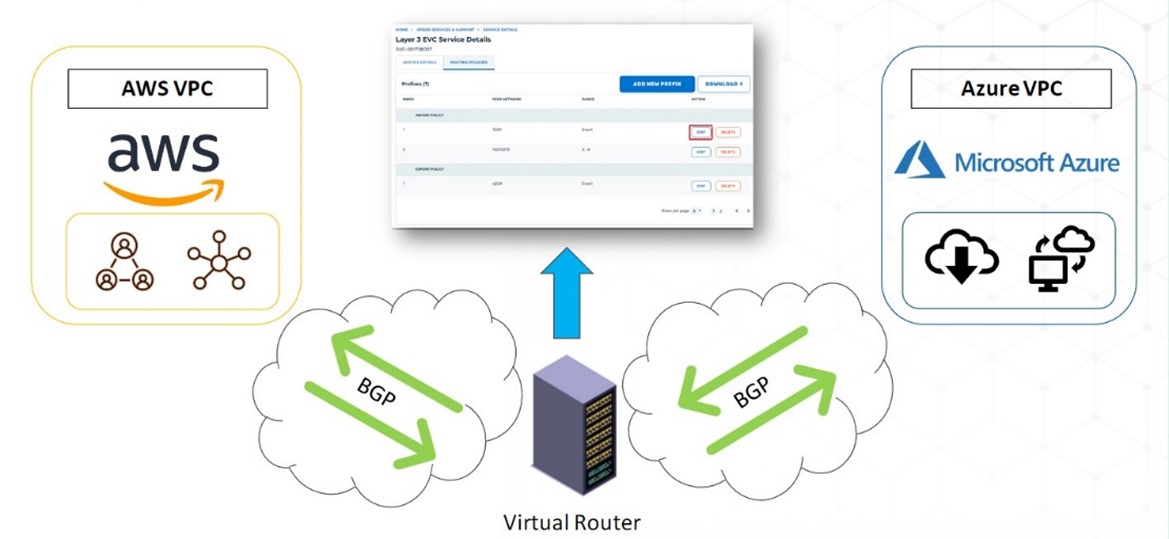
Cloud-to-Cloud Connectivity: Open Cloud Exchange Enables Integration Between Major Clouds
Speed, scalability, savings. These goals form the backbone of most enterprise IT strategies. So, it’s no surprise that businesses are soaring to the cloud to achieve them, literally and figuratively.
Cloud technology has matured, making hybrid and multicloud approaches the norm. However, IT teams have discovered that the public cloud may not be appropriate for all applications, and that individual public clouds have unique advantages as well as limitations. This revelation has driven 95% of businesses to make multicloud a strategic priority this past year.1
Adopting a multicloud or hybrid cloud strategy allows businesses to exploit best-of-breed capabilities and technologies that they struggle (or opt not) to implement on their own. With these approaches, they can select the right cloud platform for specific applications and interconnect them. A smart cloud strategy lowers costs, reduces outages and limits vendor lock-in. Businesses also have more flexibility to make decisions on governance and architecture.
But because these applications are siloed on different cloud platforms, it often takes expert cloud platform skills and dollars to get them to interoperate.
High Demand for Cloud Connectivity Expertise
Let’s say your business needs to deploy private customer data, but also needs to securely connect that data to a public cloud application. We see this in a lot of businesses such as healthcare providers, schools, government organizations, financial institutions – industries which require a secure environment to carry out sensitive tasks.
Typically, it is challenging and expensive to integrate cloud providers in and out of SaaS applications. Each cloud environment requires distinct knowledge of services, APIs, security protocols and other information. Management involves specialized engineers and specialized equipment. It can result in long lead times, high latency and uncontrolled costs. Without a carefully managed strategy, IT teams can be stretched too thin.
Cloud architecture expertise is high in demand. In fact, 90% of organizations are experiencing a shortage of cloud-related skills.2 Finding talent in a market like this can be like searching for a dragon in the sky. And even if you find one, the cost and time required to train and certify a new team member responsible for managing cloud strategy and implementation could be impractical. These significant investments can leave organizations with holes in their pockets and gaps in their capabilities.
That’s where our Open Cloud Exchange® (OCX) interconnection solution and MyCoreSite service delivery platform come into play. Now, cloud-to-cloud connectivity requires no specialized staff and no specialized equipment. You’re connected in a single click. Instead of concentrating on infrastructure or IT operations, the OCX lets you focus on expanding business and growing revenue. Here’s how it works.
One-Click Cloud-to-Cloud Connectivity
Through MyCoreSite and the OCX, customers can establish direct, secure and virtual connections to public clouds including AWS, Google Cloud, Microsoft Azure, Oracle and Alibaba. Traffic is passed directly from one cloud provider to another through the OCX, leveraging a virtual router. Essentially, it takes a port and divides it into multiple ethernet virtual connections to connect each cloud provider.
The process for connecting is simple. In MyCoreSite, order a virtual router, choose the bandwidth requirements and connect your CoreSite data center environment to a cloud provider. Voila! You’re connected in a matter of minutes. Customers can rapidly scale connections to multiple cloud service providers and turn on/off connections as needed. It’s a seamless experience.

The OCX addresses key network challenges by virtualizing and automating network services execution. CoreSite’s unified platform management offers native cloud onramps to the major cloud providers, allows simplified orchestration and management of cloud resources and reduces the complexity of connecting applications and networks to those clouds.
IT service providers can accelerate modernization while reducing data egress costs and improving performance and security. They can efficiently address larger markets within the digital ecosystem by providing comprehensive connectivity solutions that are more cost-effective when integrating a broader range of organizations. And because of this, they can gain and sustain a competitive advantage in the marketplace.
Businesses continue to modernize their networks and deploy more modern architecture. Just as applications need to be agile, so too must the network. With more applications moving to the cloud, it is expected that cloud spending will outpace non-cloud IT infrastructure spending for the first time.3 With that comes greater scale and complexity.
Why not simplify cloud connectivity so that IT teams can contribute to growth? As companies transition to the cloud, they not only improve productivity but are also well positioned to embrace new technologies. The promises of digital transformation can be realized.
Read our latest press release to learn more about the newest enhancements to the Open Cloud Exchange. And to see it all in action, request a demo.








